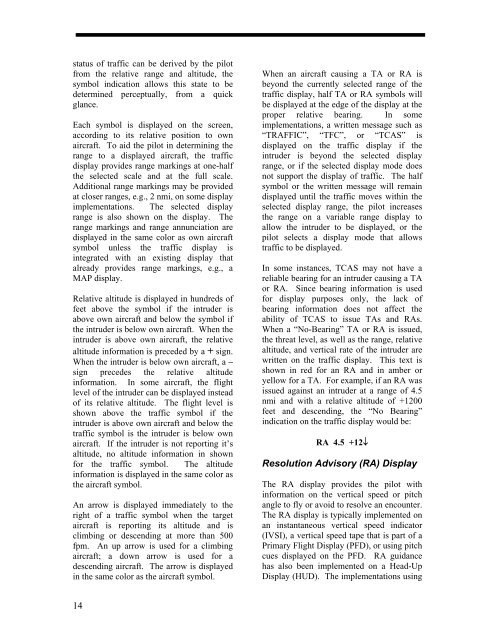Create successful ePaper yourself
Turn your PDF publications into a flip-book with our unique Google optimized e-Paper software.
status of traffic can be derived by the pilot<br />
from the relative range and altitude, the<br />
symbol indication allows this state to be<br />
determined perceptually, from a quick<br />
glance.<br />
Each symbol is displayed on the screen,<br />
according to its relative position to own<br />
aircraft. To aid the pilot in determining the<br />
range to a displayed aircraft, the traffic<br />
display provides range markings at one-half<br />
the selected scale and at the full scale.<br />
Additional range markings may be provided<br />
at closer ranges, e.g., 2 nmi, on some display<br />
implementations. The selected display<br />
range is also shown on the display. The<br />
range markings and range annunciation are<br />
displayed in the same color as own aircraft<br />
symbol unless the traffic display is<br />
integrated with an existing display that<br />
already provides range markings, e.g., a<br />
MAP display.<br />
Relative altitude is displayed in hundreds of<br />
feet above the symbol if the intruder is<br />
above own aircraft and below the symbol if<br />
the intruder is below own aircraft. When the<br />
intruder is above own aircraft, the relative<br />
altitude information is preceded by a + sign.<br />
When the intruder is below own aircraft, a –<br />
sign precedes the relative altitude<br />
information. In some aircraft, the flight<br />
level of the intruder can be displayed instead<br />
of its relative altitude. The flight level is<br />
shown above the traffic symbol if the<br />
intruder is above own aircraft and below the<br />
traffic symbol is the intruder is below own<br />
aircraft. If the intruder is not reporting it’s<br />
altitude, no altitude information in shown<br />
for the traffic symbol. The altitude<br />
information is displayed in the same color as<br />
the aircraft symbol.<br />
An arrow is displayed immediately to the<br />
right of a traffic symbol when the target<br />
aircraft is reporting its altitude and is<br />
climbing or descending at more than 500<br />
fpm. An up arrow is used for a climbing<br />
aircraft; a down arrow is used for a<br />
descending aircraft. The arrow is displayed<br />
in the same color as the aircraft symbol.<br />
When an aircraft causing a TA or RA is<br />
beyond the currently selected range of the<br />
traffic display, half TA or RA symbols will<br />
be displayed at the edge of the display at the<br />
proper relative bearing. In some<br />
implementations, a written message such as<br />
“TRAFFIC”, “TFC”, or “<strong>TCAS</strong>” is<br />
displayed on the traffic display if the<br />
intruder is beyond the selected display<br />
range, or if the selected display mode does<br />
not support the display of traffic. The half<br />
symbol or the written message will remain<br />
displayed until the traffic moves within the<br />
selected display range, the pilot increases<br />
the range on a variable range display to<br />
allow the intruder to be displayed, or the<br />
pilot selects a display mode that allows<br />
traffic to be displayed.<br />
In some instances, <strong>TCAS</strong> may not have a<br />
reliable bearing for an intruder causing a TA<br />
or RA. Since bearing information is used<br />
for display purposes only, the lack of<br />
bearing information does not affect the<br />
ability of <strong>TCAS</strong> to issue TAs and RAs.<br />
When a “No-Bearing” TA or RA is issued,<br />
the threat level, as well as the range, relative<br />
altitude, and vertical rate of the intruder are<br />
written on the traffic display. This text is<br />
shown in red for an RA and in amber or<br />
yellow for a TA. For example, if an RA was<br />
issued against an intruder at a range of 4.5<br />
nmi and with a relative altitude of +1200<br />
feet and descending, the “No Bearing”<br />
indication on the traffic display would be:<br />
RA 4.5 +12<br />
Resolution Advisory (RA) Display<br />
The RA display provides the pilot with<br />
information on the vertical speed or pitch<br />
angle to fly or avoid to resolve an encounter.<br />
The RA display is typically implemented on<br />
an instantaneous vertical speed indicator<br />
(IVSI), a vertical speed tape that is part of a<br />
Primary Flight Display (PFD), or using pitch<br />
cues displayed on the PFD. RA guidance<br />
has also been implemented on a Head-Up<br />
Display (HUD). The implementations using<br />
14



